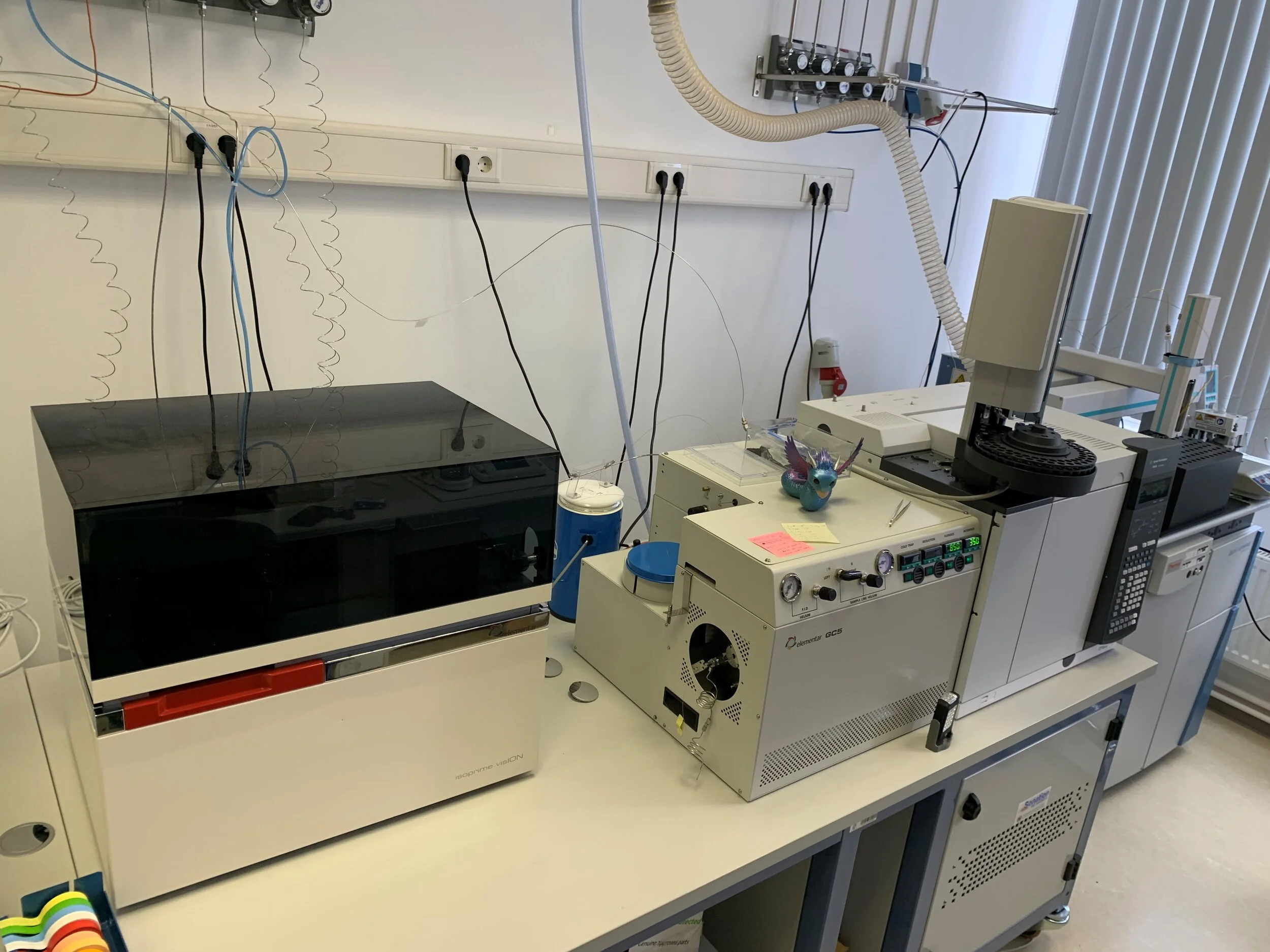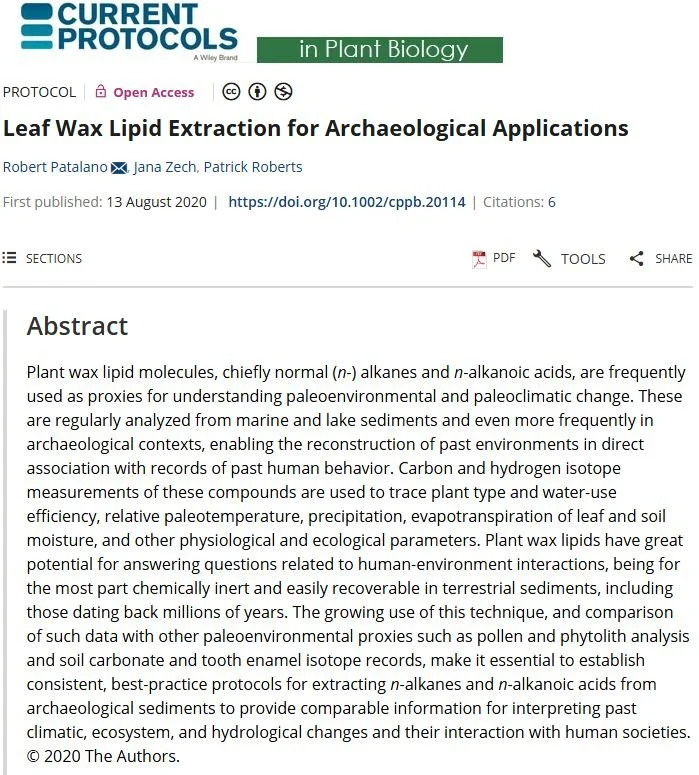LAB METHODS & TECHNIQUES
I have extensive training in organic geochemistry and in multiple gas chromatography and mass spectrometry analytical techniques, including compound specific stable isotope ratio mass spectrometry.
As an archaeologist, my laboratory methods focus on organic geochemistry and lipidomics to reconstruct past climates and environments. What sets me apart from geochemists who traditionally do this type of work is that I have formal training in archaeology and paleoanthropology, which I believe gives me somewhat of a unique perspective when answering questions concerning early hominin paleoecology and the role climatic and environmental variability had in shaping human origins and diversification. Over the years, I have developed a strong, specialist skillset in established and novel biogeochemical methods for plant ecology and water availability, as well as anthropogenic fire use and population dynamics, and lead and contribute to studies that are adding to the wider debates concerning environmental processes, cultural change, and human evolution in eastern, southern, and northern Africa as well as western, southern, and southeastern Asia.
Total Lipid Extraction
Total lipid extraction (TLE) is a technique based on the like-dissolves-like principle of solvent separation, whereby solvents readily dissolve analytes of approximately the same polarity. Typically, solvents are passed through a ground plant, rock, or soil or sediment samples to isolate biomarkers. There are multiple ways to extract lipids, of which the most commonly used are Soxhlet apparatus, accelerated or pressurized solvent extraction, and ultrasonic extraction. These different techniques share inherent principles in that the goal of each is to ensure high analyte recovery while reducing time and solvent consumption and avoiding carryover or cross-contamination between samples.
Soxhlet is designed to extract organic materials by distillation and the continuous recycling of solvent. This method is the most commonly used extraction technique, even though it is gradually being replaced by automated solvent extraction . However, it is the longest of the techniques and can take up to 72 hours to finish extracting total lipids from samples.
Although somewhat rare pieces of equipment in many labs, accelerated or pressurized solvent extraction systems are quickly being adopted because of their efficiency in extracting compounds over short time periods. These machines use elevated temperature and pressure in combination with organic solvents to increase the efficiency of the extraction process. The higher temperatures increase the extraction speed and the solubility of lipid analytes while elevated pressure allows temperatures above the solvent boiling points to be used, which is essential given that the boiling points of organic solvents and target lipid compounds are often low. Operating at elevated pressure also expedites and enhances the overall extraction, as pressurized solvent is forced into and through the pore spaces of the sediments, improving biomarker recovery.
Ultrasonic extraction is typically used when only a small amount of sample (≤10 g) is available or where it is desirable to quickly test the organic content in a sediment. Depending on the number of samples being extracted, however, it can be a very time-consuming process. It involves agitating the sample using cavitation bubbles generated by high-frequency sound to remove total lipids bound in a sedimentary matrix. The major benefit of ultrasonic extraction is that an ultrasonic cleaner is a relatively inexpensive instrument and may be the most practical extraction option for laboratories just beginning biomarker analysis.
Column Chromatography
Example of a silver nitrate/silica gel column in an ∼5-inch borosilicate glass pipet. Notice the slight discoloration between the silver nitrate (SiAgNO3) and the silica gel. The n-alkanes in the Neutral fraction are being eluted through the column with hexane. From Patalano et al., 2020.
Column chromatography is an analytical technique used to separate organic compounds into individual components, so that these components can be analyzed by gas chromatography and mass spectrometry. Like total lipid extraction, column separation is based on the principle that like dissolves like, whereby solvents readily elute analytes of approximately the same polarity. Generally, the targeted analyte is dissolved in various organic solvents and loaded onto the column, and due to solvent polarity, the different compounds of the analyte either adhere to or elute through the column.
I typically use Silica Gel and Aminopropyl column chromatography to isolate plant wax biomarkers from archaeological sediments. Silica Gel columns separate organic compounds according to polarity; silica is a polar adsorbent so non-polar compounds (e.g., n-alkanes) elute before more polar ones (e.g., n-alkanoic acids). I often fuse my silica gel with silver nitrate as the silver ions interact with unsaturated compounds (e.g., alkenes) so that straight-chain hydrocarbons (n-alkanes and n-alkanoic acids) can be isolated from other neutral or acidic compounds.
Aminopropyl column chromatography is a silica-based stationary-phase extraction technique in which the silica gel is functionalized with amino groups. Silica is a polar adsorbent, so nonpolar compounds (e.g., n-alkanes) elute before more polar compounds. The ability of aminopropyl columns to retain acids when non-polar fractions are eluted first, and then release the acids when eluted with organic solvents like acetic acid in ether, make this the ideal technique for quickly separating carboxylic acids from the neutral lipid fractions before further separation into n-alkanes and n-alkanoic acids.
Three mass spectra for the molecular ions representing the mass of the C29-C33 n-alkanes. Each compound is identified by its mass-to-charge ration (m/z), which for n-alkanes increases by 14 mass units—corresponding to one carbon (12 atomic mass units, amu) and two hydrogen (2 amu)—per additional backbone carbon. From Patalano et al., 2020.
Gas Chromatography Mass Spectrometry & Isotope Ratio Mass Spectrometry
GC-MS is an analytical technique for identifying and quantifying organic compounds in complex matrices. The gas chromatograph separates compounds by (i) volatilizing a sample in a heated inlet, (ii) using an inert carrier gas (e.g., helium) to transfer the sample from the inlet through a fused silica capillary column containing a stationary-phase coating, and (iii) passing the sample from the column into the mass spectrometer, which provides structural information on the injected compounds. The mass spectrometer ionizes the analytes eluting through the GC column as they enter the detector, and the ions are deflected by a magnetic field and finally distinguished electrically according to their mass-to-charge ratio (m/z). The fragmentation of the ions that represent the original molecule injected into the GC is then used to determine the structure of targeted compounds. The data resulting from GC-MS are known as “mass spectra” and represent the m/z value and abundance of a given molecular ion (M+).
Gas chromatography isotope ratio mass spectrometry (GC-IRMS, or IRMS) follows the same principles as GC-MS, except that instead of yielding structural information by scanning fragmented ions, IRMS measures, with high precision, small variations in the relative abundances of carbon (13C/12C) and hydrogen (2H/1H or D/H) isotopes, as well as nitrogen (15N/14N), oxygen (18O/16O), sulfur (34S/32S), and other elements and their isotopes. Samples are first converted to gas (e.g., H2, CO2) before the mass spectrometer calculates the corresponding ratio of ions within the gas and monitors the mass-to-charge (m/z) ratios of the target compounds.
Additional Training
In addition to the above biomarker geochemistry protocols, I have training in compound, digital, and scanning electron microscopy, pyrolysis gas chromatography mass spectrometry, bulk isotope analysis of tooth enamel carbonates, and to a lesser extent, lithic, starch, and phytolith analysis.



